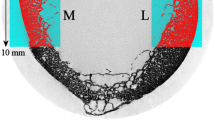Summary
Distortion of the dimensions of large cancellous bone specimens during all stages of histological processing and cutting of paraffin sections in various directions was measured on Xerograms taken from slabs and then sections from human femoral heads. Although some shrinkage in both width and height of the specimens occurred at every stage of the histological preparation, the main shrinkage (about 6%) occurred during the embedding process, and mainly in the cutting of the sections (10–27%, depending on the direction the knife was approaching the specimen). The shrinkage of cancellous bone tissue during histological preparation appears to be a constant factor, but its magnitude during the individual stages of the preparation can be predicted. For the quantitative measurements a comparison of two Xerograms—one taken from the original fresh bone slab and the other from the final stained section—would reveal the exact extent of the tissue shrinkage.
Similar content being viewed by others
References
Patten BM, Philpott R (1921) The shrinkage of embryos in the processes preparatory to sectioning. Anat Rec 20:393–413
Miles AEW, Linder JE (1953) Polyethylene glycols as histological embedding media: with a note on the dimensional change of tissue during embedding in various media. J R Microsc Soc 72:199–213
Smith A (1962) Tissue shrinkage caused by attachment of paraffin sections to slides: its effect on staining. Stain Technol 37:339–345
Brain EB (1966) The Preparation of Decalcified Sections. Charles C Thomas, Springfield, IL
Bahr, Broom, Friberg (1957) quoted in: Culling CFA (1974) Handbook of Histopathological and Histochemical Techniques, 3rd edn. Butterworths, London
Ráliš ZA (1979) Recording of hard tissue morphology by electrostatic (Xerox) copying. Med Lab Sci 36:391–392
Hart BL, Lane J, Watkins G, Ráliš ZA (1981) A technique for cutting slices from femoral heads and other awkwardly shaped bones. Calcif Tissue Int 34:000–000
Ráliš ZA, Ráliš M (1975) A simple method for demonstration of osteoid in paraffin sections. Med Lab Technol 32:203–213
Drury RAB, Wallington EA (1967) Carleton's Histological Technique, 4th ed. London, Oxford University Press
Lillie RD (1965) Histopathologic Technique and Practical Histochemistry, 3rd ed. McGraw-Hill, New York
Wallington EA (1972) Histological Methods for Bone. Laboratory Aids Series, Butterworths, London
Author information
Authors and Affiliations
Rights and permissions
About this article
Cite this article
Lane, J., Ráliš, Z.A. Changes in dimensions of large cancellous bone specimens during histological preparation as measured on slabs from human femoral heads. Calcif Tissue Int 35, 1–4 (1983). https://doi.org/10.1007/BF02404997
Issue Date:
DOI: https://doi.org/10.1007/BF02404997




